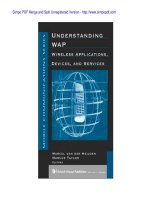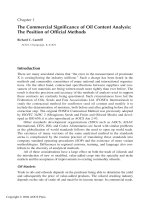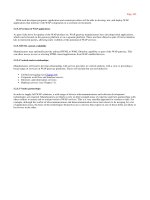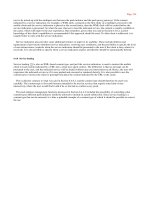Understanding WAP Wireless Applications, Devices, and Services phần 1 ppsx
Bạn đang xem bản rút gọn của tài liệu. Xem và tải ngay bản đầy đủ của tài liệu tại đây (430.41 KB, 27 trang )
TEAMFLY
Team-Fly
®
Page i
Understanding WAP
Wireless Applications, Devices, and Services
Page ii
For a listing of recent titles in the Artech House
Mobile Communications Library
, turn to the back of this book.
Page iii
Understanding WAP
Wireless Applications,
Devices, and Services
Marcel van der Heijden
Marcus Taylor
Editors
Page iv
Disclaimer:
This netLibrary eBook does not incude the ancillary media that was packaged with the originally printed version of the book.
Library of Congress Cataloging -in-Publication Data
Understanding WAP: wireless applications, devices, and services / Marcel van der
Heijden, Marcus Taylor, editors.
p. cm. — (Artech House mobile communications library)
Includes bibliographical references and index.
ISBN 1-58053-093-1 (alk. paper)
1. Wireless communication systems. I. Heijden, Marcel van der.
II. Taylor, Marcus. III. Artech House telecommunications library.
TK5103.2.U53 2000
621.3845— dc21 00-030611
CIP
British Library Cataloguing in Publication Data
Understanding WAP: wireless applications, devices, and services. — (Artech House
mobile communications library)
1. Wireless communication systems 2. Computer network protocols
I. Heijden, Marcel van der II. Taylor, Marcus
621.3'845
ISBN 1-58053-093-1
Cover and text design by Darrell Judd
© 2000 ARTECH HOUSE, INC.
685 Canton Street
Norwood, MA 02062
All rights reserved. Printed and bound in the United States of America. No part of this book may be reproduced or utilized in any form
or by any means, electronic or mechanical, including photocopying, recording, or by any information storage and retrieval system,
without permission in writing from the publisher.
All terms mentioned in this book that are known to be trademarks or service marks have been appropriately capitalized. Artech House
cannot attest to the accuracy of this information. Use of a term in this book should not be regarded as affecting the validity of any
trademark or service mark.
International Standard Book Number: 1-58053-093-1
Library of Congress Catalog Card Number: 00-030611
10 9 8 7 6 5 4 3 2
Page v
Contents
Preface
xiii
1 Introducing the Wireless Application
Protocol
1
1.1 Introduction 1
1.2 How it all started 2
1.2.1 Why was this done together? 2
1.2.2 A worldwide solution 3
1.2.3 The WAP Forum Ltd. 3
1.2.4 The first commercial version of WAP 3
1.3 A brief description of what it is all about 4
1.3.1 Optimized for wireless communications 4
1.3.2 Deck of cards 4
1.3.3 The WAP stack 4
1.4 Applications using WAP 7
1.4.1 Information retrieval on the Internet 7
1.4.2 The serviceperson application 8
1.4.3 Notification applications 8
1.4.4 Mobile electronic commerce 8
1.4.5 Telephony applications 8
1.5 Benefits and market opportunities 9
1.5.1 Operator benefits 9
1.5.2 Content provider benefits 10
1.5.3 End user benefits 10
1.6 Challenges to the network operator 10
1.6.1 Creating a service package 11
Page vi
1.7 What is next? 12
1.7.1 Interoperability 12
1.7.2 Products, of course! 12
1.7.3 Liaisons with other organizations 12
1.8 Conclusions 13
2 The Wireless Application Environment
for Creating WAP Services and
Applications
15
2.1 Introduction 15
2.2 The wireless markup language 17
2.2.1 Decks of cards 19
2.2.2 User input 20
2.2.3 Task invocation 21
2.2.4 Events 22
2.2.5 Variables and context 23
2.2.6 Other features of WML 24
2.3 Wireless markup language script 25
2.3.1 WMLScript variables and datatypes 26
2.3.2 WMLScript functions 27
2.3.3 Differences between ECMAScript and
WMLScript
27
2.3.4 WMLScript statements 27
2.3.5 Wireless markup language script standard
libraries
29
2.4 Byte-encoded WML and compiled WMLScript 29
2.4.1 Encoding of WML 30
2.4.2 Compilation of WMLScript 30
2.5 Overview of the wireless telephony application
interface
30
2.5.1 WTAI libraries 32
2.6 Migrating from WWW to WAP 33
2.6.1 WML and HTML 33
2.6.2 WMLScript and JavaScript 34
2.6.3 Using CGI and WAP gateways 34
2.7 Markup languages and XML 35
2.8 User agent capabilities and content negotiation 36
2.9 Miscellaneous elements of WAP of interest to
developers
37
2.9.1 Push 37
2.9.2 Wireless session protocol and HTTP headers 37
2.9.3 Binary encoding of wireless session protocol
headers
38
2.9.4 Cache control using wireless session protocol
headers
38
Page vii
2.10 Available software tools 39
2.11 WML language reference 39
3 Designing Effective User Interfaces for
WAP Services
45
3.1 Introduction 45
3.2 The user interface design process 48
3.2.1 Holistic process 48
3.2.2 Customer satisfaction 49
3.2.3 Designing for tasks 50
3.3 Design principles 52
3.3.1 Economy 52
3.3.2 Modularity 52
3.3.3 Personality 52
3.3.4 Synthesis 53
3.4 Input techniques 53
3.4.1 Avoid text entry 54
3.4.2 Defaults 55
3.4.3 Lists 55
3.5 Navigation models 56
3.5.1 Form-based navigation 56
3.5.2 Question-and-answer navigation 57
3.5.3 Put the user in control 58
3.6 Testing the user interface 59
3.6.1 Different devices 60
3.7 Future developments 61
3.7.1 First-class WAP services 61
3.7.2 Adaptive user interfaces 61
3.8 Conclusions 62
4 Wireless Telephony Application:
Telephony in WAP
65
4.1 Introduction 65
4.2 WTA architecture overview 67
4.3 The WTA framework components 68
4.3.1 The WTA user agent 68
4.3.2 The WTA interface 70
4.3.3 The repository 71
Page viii
4.3.4 An event-handling mechanism 72
4.4 The WTA server 72
4.5 WTA services and WTA service providers 73
4.6 WTA security model and access control 73
4.7 WTAI— interfacing WAP with the mobile
network
74
4.7.1 The WTA interface design 74
4.7.2 Public WTAI 76
4.7.3 Network-common WTAI 77
4.7.4 Network-specific WTAI 78
4.7.5 Calling WTAI functions 79
4.7.6 WTA events 79
4.8 Repository 80
4.8.1 A persistent storage for fast service access 80
4.8.2 Channels and resources 80
4.8.3 Channel loading and unloading 83
4.9 Event handling 84
4.9.1 Event bindings 84
4.9.2 Event-handling procedure 84
4.9.3 Event parameters 86
4.9.4 Example: temporary event binding 87
4.9.5 Example: global event binding 87
4.10 Building a WTA application 88
4.10.1 The incoming-call handler service 88
5
Integrating WAP Gateways in Wireless
Networks
97
5.1 Overview 97
5.2 Positioning of WAP functionality in a mobile
network
98
5.2.1 WAP gateway 98
5.2.2 WAP-enabled mobile devices 99
5.2.3 WAP origin server 99
5.2.4 Wireless telephony application server 100
5.2.5 Additional support offerings by WAP gateway
manufacturers
100
5.3 Functional requirements of a WAP gateway 103
5.3.1 Standardized functionality specified by the
WAP Forum
104
5.3.2 Functionality required in integrating the
standardized WAP functionality to an actual mobile
network implementation
106
5.3.3 Value-added services provided by
manufacturers
109
5.4 WAP gateway future enhancements 113
Page ix
5.4.1 Push applications 114
5.4.2 Security 114
5.4.3 Provisioning server 114
5.4.4 New generation mobile networks 114
5.4.5 Interim proprietary solutions 115
5.5 The WAP gateway— product differentiation
factors
115
6 Introduction to WAP Push Services 117
6.1 Introduction 117
6.2 Definition of WAP push 118
6.3 What do we have today? 118
6.3.1 Push on the Web 119
6.3.2 Push in the wireless domain 120
6.3.3 Can the solutions converge? 120
6.4 The WAP push framework 121
6.4.1 Gateways, proxies, and servers 121
6.4.2 Push initiators 123
6.4.3 Push access protocol 124
6.4.4 The push proxy gateway 126
6.4.5 Push OTA protocol 130
6.4.6 Mobile client behavior 131
6.4.7 Service indication 132
6.4.8 Service loading 134
6.5 Security aspects 135
6.5.1 Internet security 135
6.5.2 WAP security 135
6.5.3 End-to-end security 136
6.5.4 Transitive trust 136
6.6 Making it happen 137
6.6.1 Understanding customer value 138
6.6.2 Understanding the value chain 138
6.6.3 Making the money 139
6.6.4 Some examples of push services 140
7 Wireless Application Protocol Security 143
7.1 Introduction 143
7.1.1 Case 1 144
7.1.2 Case 2 144
Page x
7.1.3 Case 3 144
7.1.4 Case 4 145
7.2 Overview of cryptography 146
7.2.1 Symmetric-key cryptography 148
7.2.2 Public-key cryptography 148
7.2.3 Hybrid solutions 151
7.2.4 Cryptographic schemes 151
7.2.5 Public-key infrastructures 152
7.2.6 Summary 154
7.3 Security issues in a wireless environment 154
7.4 Security in WAP 156
7.4.1 Introduction 156
7.4.2 The WTLS protocol in detail 157
7.4.3 Security attributes of wireless transport layer
security
159
7.4.4 Comments on WTLS and WAP security 162
7.5 Conclusions 164
8 WAP for Operators 165
8.1 Introduction and background 165
8.2 Operator needs 168
8.3 Customer requirements 170
8.4 Critical success factors for WAP service
introduction
175
8.4.1 Generic critical success factors 175
8.4.2 WAP-specific critical success factors 177
8.5 WAP services 178
8.6 WAP business models from an operator's
perspective
182
8.7 Conclusion 185
9 Extending Integrated Unified
Messaging Solutions Using WAP
187
9.1 Introduction 187
9.2 Unified messaging concept 188
9.3 Unified messaging and the wireless application
protocol
189
9.4 Architecture of wireless application protocol
access to unified messaging system
190
9.5 Using the wireless application protocol to
expand unified messaging services
191
9.5.1 The WAP portal 191
TEAMFLY
Team-Fly
®
Page xi
9.6 Wireless application protocol access to unified
messaging services
192
9.6.1 Accessing voice and fax messages 192
9.6.2 Accessing e-mail messages 194
9.6.3 Directory services 196
9.6.4 Notification services 199
9.6.5 Service provisioning and billing 201
9.6.6 Self-provisioning with WAP 202
9.7 Corporate unified messaging systems 202
9.7.1 Network layout of the corporate unified
messaging solution
203
9.7.2 Wireless application protocol messaging and
additional services in corporate systems
205
10 Mobile Financial Services and
Applications
207
10.1 Introduction 207
10.2 A new electronic channel is born 207
10.3 Who are the users of this new channel? 208
10.4 Previous constraints to mobile commerce 209
10.5 Breakthrough technology 210
10.6 Strengths and weaknesses of the mobile
channel
210
10.7 The current range of mobile devices 212
10.7.1 SMS messages on GSM phones 212
10.7.2 USSD messages on GSM phones 213
10.7.3 Applications on the SIM of the phone 214
10.7.4 Microbrowser in smart phones and PDAs 214
10.8 Resident applications on the mobile device 216
10.9 Choice of mobile commerce platform 216
10.10 Existing mobile financial services and
applications
216
10.11 Principles of building scaleable n-tier
applications
220
10.12 Building WAP applications 223
10.13 Building multichannel applications 226
10.14 Building financial WAP applications 229
10.15 Sample banking application 232
10.16 Possible mobile financial services
applications using WAP
233
10.17 The role of other service delivery channels 235
10.18 The personal mobile phone and customer
relation management
235
10.19 Next generation of WAP-based financial
services and applications
236
10.20 Conclusion
Page xii
Acronyms
239
About the Authors
243
Index
247
Page xiii
Preface
Over the last five years or so a revolution has taken place, and continues to do so, that is changing the way we
communicate and interact with each other and our environment. The advent of the Internet and the ubiquitous presence of
mobile personal communications systems are the most prominent examples of this. The Internet has made it possible to
exchange information instantly on a worldwide scale and has released unprecedented amounts of information into the
public domain. Mobile communications allowed personal communications on an anytime, anywhere basis.
While mobile access is possible using standard technology, more is needed to make mobile access truly seamless. The
creation of a world standard for mobile Internet access and information access would ensure a rapid growth and a basis
for all mobile communications users to interact. The wireless application protocol (WAP) is an attempt to do just that,
and judging by the industry support at the time of this writing, a successful one.
The impact of WAP on all parties in the value chain of services delivery and information exchange is hard to
underestimate. WAP will be an additional channel for some to offer their services, a new enabler for others who can now
offer services that could not be offered before. It will be a treat for some and an opportunity to others, depending on the
approach taken. Most of all, it will release an enormous potential of services and applications for the end users. In many
ways WAP will probably change the world as the Internet and mobile communications have done before.
Page xiv
Understanding WAP: Wireless Applications, Devices, and Services is a comprehensive description of many aspects of
WAP. It will explain some technicalities of WAP and the system elements involved for a full understanding of the
potential of WAP, though it is not specifically geared towards engineers only. It will also describe the impact of WAP on
wireless operators and service providers. This book is aimed at engineers and technical managers as an introduction to
WAP and at business managers as a way to gain an understanding of the technical background of WAP.
Finally, the editors wish to express their gratitude to all who have contributed to the creation of this book and who
have made working on this book an interesting experience.
Marcel van der Heijden and Marcus Taylor
Editors
Page 1
Introducing the Wireless Application Protocol
Per Ocklind
1.1 Introduction
Today, the wireless network is mainly used for voice communication, where voice mail might be the most popular value-
added service, if any. However, a new buzzword is increasingly being mentioned in the marketplace: WAP, or wireless
application protocol.
WAP is a completely new concept. It provides data-oriented (nonvoice) services to the mass market and is capable of
being beneficial, anywhere and anytime, to far more end users than the personal computer. WAP is a global standard that
is independent of the underlying bearer. With WAP, a new dimension will be added to the use of mobile phones, through
the introduction of new data
-
oriented mass
-
market services.
CHAPTER
1
Contents
1.1 Introduction
1.2 How it all
started
1.3 A brief
description of
what it is all
about
1.4
Applications
using WAP
1.5 Benefits
and market
opportunities
1.6 Challenges
to the network
operator
1.7 What is
next?
1.8 Conclusions
Page 2
1.2 How it all started
In mid-1997 Ericsson, Motorola, Nokia, and Phone.com (previously Unwired Planet) came to an agreement to mutually
define a new protocol for mobile devices. The objective was to offer new wireless datacommunication services to end
users, both in the form of telecommunication-related and Internet-oriented applications.
1.2.1 Why was this done together?
Over the years, several protocols have been defined by various players in the market, for various types of applications. In
the beginning Unwired Planet had its handheld device markup language (HDML), a protocol for Internet access to be
used over cellular digital packet data (CDPD) networks. At the CeBIT exhibition in 1997, Nokia launched a protocol
called tagged text markup language (TTML), a protocol with a similar focus as the HDML protocol, but designed to be
used in the GSM world. Ericsson, in turn, was in the process of launching a protocol mainly focusing on
telecommunications-related and messaging applications (e.g., call handling and call control) to be used inside the GSM
networks called intelligent terminal transfer protocol (ITTP).
These three protocols represented only a fraction of the different protocols defined by different organizations and
available in the marketplace. This fragmentation prevented the market for wireless applications from taking off. In order
to clean up this fragmentation, forces were joined in defining a common platform, a common protocol, embracing
Internet access, messaging (see Chapter 9) and telecommunications related applications, and everything in between (see
Figure 1.1).
It was realized that if this common platform was not created, and proprietary projects and solutions continued to be
developed, the consequence would be that the market would take up an unresponsive attitude to these projects; it would
remain in an idle mode.
The first joint meeting took place in Seattle in June 1997 and was followed by quite an extensive meeting schedule.
The intention from the start was to broaden the group of companies working with WAP. However, as all parties involved
felt that it was very important to get a first draft specification out as soon as possible, it was stated that the doors for new
members would be opened only when the first draft was released and available.
Page 3
Why a new standard?
Figure 1.1 Schematic overview of how the different services and enabling technologies are related and
replaced by WAP.
1.2.2 A worldwide solution
Since one of the main goals was to make this protocol global and generic, we stressed that it should be independent of the
underlying bearer. That is, it should operate on any cellular bearer (e.g., GSM, D-AMPS, CDMA, and PDC) and even on
nonvoice systems, such as Mobitex and paging systems.
1.2.3 The WAP Forum Ltd.
In December 1997, the four parties formed a company, WAP Forum Ltd., to control and manage the continued
development of WAP. The first draft of the WAP 1.0 specifications was released in April 1998, and consequently the
door for new members to enter the WAP Forum was opened. In June 1998, one year after the first joint meeting, the
WAP Forum had its first meeting with the new member constellation. The number of members at this time was
approximately 40.
1.2.4 The first commercial version of WAP
In May 1999, 11 months after the release of the WAP 1.0 specifications (and after a large number of working meetings),
the first commercial version of WAP (WAP 1.1) was finalized. The number of members has increased steadily, and the
present figure (May 2000) is now more than 200 members. By now, many implementations of WAP components are
Page 4
being introduced and an enormous diversity of WAP services have been rolled out at an impressive pace.
1.3 A brief description of what it is all about
The following can be seen as an executive summary of WAP in some detail from a technical standpoint. These
components will be described in more detail in separate chapters of this book.
1.3.1 Optimized for wireless communications
In addition to providing end users with new services, WAP has been designed for the economical use of the resources
available in the telecommunications network. Over-the-air interface communication is binary coded to use the bearer
services as efficiently as possible. Message headers and parts of messages in plaintext format that are frequently sent are
represented as bytes. The original content is then restored in the receiver (the WAP browser).
In the wireless world, the handset also sets some limitations such as display size, number of keys, CPU capacity, etc.
This means that the applications will differ from the ones we are using for normal Internet surfing.
1.3.2 Deck of cards
The handling of services is based on a deck of cards metaphor. A deck is sent from the network to a user's terminal when
he or she enters a command to invoke a service. The user can then navigate through the complete deck to make a choice.
If the desired choice is not included in the deck, another deck can be requested by command. When the user has made his
or her choice and entered the relevant command, the requested action is performed or information is retrieved. Depending
on the capacity of the mobile phone, the decks and cards can be cached in the WAP phone (terminal) for future use.
1.3.3 The WAP stack
One of the objectives of specifying the WAP was to make the mobile phone a first-class citizen of the Internet.
Therefore, it was only natural that an Internet-oriented approach be adopted. As Figure 1.2 shows, the WAP stack is
similar to the layers used in the Internet.
The following entities are defined in WAP.
Page 5
Wireless application protocol
Figure 1.2 Schematic representation of the WAP stack of protocols (right) and entities and the Internet
protocol stack (left). The two protocol stacks are similar in many ways.
1.3.3.1 Microbrowser
The microbrowser can be compared to a standard Internet browser, for example, Netscape Navigator or Microsoft
Internet Explorer. The applications we are accessing must be written in the new markup language defined within WAP,
which is called wireless markup language (WML). WML, however, is structured rather similarly to HTML (WML
follows XML as opposed to HTML) and can easily be converted from it. The conversion (or filtering) of existing HTML
content to WML is not covered within the WAP specification. The same applies to the actual implementation of a
browser. The WAP specification describes the minimal functionality that they should contain.
1.3.3.2 WMLScript
The wireless markup language script (WMLScript) is a scripting language very similar to JavaScript/ECMAScript. It
provides a means of reducing airtime by enhancing the capability of the handset; that is, it enables the handset to process
more information locally before sending it to the server.
Page 6
Chapter 2 describes in more detail the wireless application environment (WAE), of which WML and WMLScript are
parts, from a developer's perspective.
1.3.3.3 Wireless telephony application and the WTA interface
The telephony part of WAP is called the wireless telephony application (WTA). A WTA application is using the wireless
telephony application interface (WTAI) in order to create call-control and call-handling applications, for example, the
definition of call chains and various options when a call is received, integrated within the visual WAP user environment.
The WTAI ensures that the WTA user agent can interact with mobile network functions (e.g., setting up calls) and
device-specific features (e.g., phonebook manipulation). For further information, refer to Chapter 4, where WTA and
WTAI are described in more detail.
1.3.3.4 Content formats
The content formats that are supported in WAP include (among others) business cards (vCard) [1], calendar events
(vCalendar) [2], and so on. Thus, existing standards and technologies are leveraged and can be easily migrated into WAP
applications and services.
1.3.3.5 A layered telecommunication stack
Includes transport, security (see Chapter 7), and session layers.
1.3.3.6 The WAP gateway
In order to reach the Internet world, the WAP-enabled phones must travel via a WAP gateway (G/W). The WAP G/W
acts as an intermediary, connecting the mobile network and the Internet by translating the hypertext transfer protocol
(HTTP) to the wireless session protocol (WSP). This is often referred to as protocol translation.
For general WAP services, the operator offering generic access to WAP applications on the Internet will typically host
the WAP gateway. However, some companies or organizations might want to let their employees access intranet
information (i.e., information inside the firewall). In this case, the company will have a WAP G/W of its own.
Figure 1.3 gives a simplified picture of the different WAP entities within the wireless network.
WAP gateways or proxies may also perform a conversion of the content that is being requested by the WAP client. A
WAP browser may, for instance, request an HTML page, which is then converted into WML by
TEAMFLY
Team-Fly
®
Page 7
Simplified picture of WAP network architecture
Figure 1.3 Network diagram giving an overview of the different entities that may exist in a wireless
network that supports WAP.
the WAP gateway. Similarly, a plaintext WML file that is requested may be encoded into the binary format before it is
sent to the WAP client. Chapter 5 describes in more detail WAP gateways and how they can be employed.
1.4 Applications using WAP
With WAP a user with a mobile phone supporting WAP will have access to information that is available on the Internet
in WML and WMLScript format as well as possible telephony applications provided by the operator. WAP encompasses
almost the entire wireless community, making it ubiquitously available to mobile communications users. This suggests
that (besides the physical characteristics of the WAP-enabled device) only the imagination sets the limit to what is
possible with WAP. Listed here are a few examples of possible applications.
1.4.1 Information retrieval on the Internet
WAP can be employed to reach information on the Internet. However, the WAP browser cannot be used exactly in the
same way as an ordinary
Page 8
‘‘surfing tool,” since the mobile phone sets some limits on input and output capability, memory size, and so forth. As the
user experience will be of paramount importance for a broad take-up of WAP services, Chapter 3 discusses WAP
applications from a usability and user interface design perspective.
1.4.2 The serviceperson application
With a WAP-enabled mobile phone, servicepeople on duty can access their company inventory to check whether or not a
spare part is available and directly inform customers about the situation. Of course, they can use the same application to
order spare parts, and will immediately receive a confirmed delivery date. When a job is done, the service team members
can sign off and report the current status of the site.
1.4.3 Notification applications
By means of agents residing in servers, users can be notified of e-mail and voice mail messages that have been sent to
them. They can interactively request that more information be sent to their phones, or order a printout on a fax machine
of their choice.
Users interested in buying or selling shares can define a buying or selling profile that shows, for example, what stocks
they are interested in, and at what quote they might be willing to buy or sell. When a specific quotation has passed a
defined trigger value, the agent notifies them and asks if they want to make a transaction. Such notifications can be
“pushed” to the mobile WAP user using the push facilities provided by the WAP specifications. Chapter 6 describes the
push architecture and implementation issues in considerable detail.
1.4.4 Mobile electronic commerce
Users can have access to payment services for bank transactions, ticket offices and wagering systems, and electronic
auctions. The role of WAP in mobile financial services is discussed extensively in Chapter 10.
1.4.5 Telephony applications
A user can have access to services that handle call setup, in combination with other services provided by a wireless
operator. A typical example involves a menu (see Figure 1.4), defined by the user, which is displayed for each incoming
call. This menu allows the user to decide whether to answer or reject the call, or to forward it to another extension or to a
Page 9
voice mail service. The WTA part of the WAP specifications is extensively described in Chapter 4.
1.5 Benefits and market opportunities
WAP will add quite a few benefits and opportunities for all players on the wireless market. Listed here are a number of
these opportunities.
1.5.1 Operator benefits
For the network operators, WAP means that they get a tool by which they can offer a new category of services to end
users. They can quickly create unique and innovative services and provide access to third-
party services that are available
on the Internet. Operators can improve their customer services and help desks with a reduced cost by providing access to
information residing on their networks. With the introduction of WAP, they will also remotely be able to tailor the menus
and the interface of customers' telephones to further differentiate their services. In many respects, WAP will be a tool for
operators to improve their services and thus reduce churn. Chapter 8 describes in detail the issues that arise around the
deployment of WAP by operators.
Figure 1.4 Typical example of a text-based WAP-enabled phone where WAP is used to create an interface
to the phone's functionality.
Page 10
1.5.2 Content provider benefits
WAP allows the content provider to aggregate, create, and broker content that can be accessed from practically anywhere
using the WAP distribution channel and interface. This content, which is available on a server, can be accessed from any
wireless device almost anywhere on the globe. The current trend of managing content in XML [
3
] format, with the aim of
effectively separating the content from the media format used for distribution, also allows for the distribution of this
content through a number of different channels such as WAP, HTML, text-to-speech, interactive television, etc.
1.5.3 End user benefits
More and more people are using their PCs to retrieve information from global sources. Many users have found increased
possibilities of executing services on their fixed phones around-the-clock using an interactive voice-response system.
Now, even greater possibilities are facilitated through services based on WAP technology (see
Figure 1.5). To make it
practical to use a phone for accessing services, the user must be able to personalize the services, for example, from a Web
page.
Thanks to WAP, end users can access the following services, and many more, by entering the relevant choice via their
terminal:
l
Banking;
l
Stock exchange quotations;
l
All types of news, such as sports, financial, etc.;
l
Weather forecasts;
l
Corporate applications such as inventory balance, enterprise resource planning applications, etc.;
l
Tele-services;
l
Games, gambling, and other entertainment applications;
l
Geographic information.
1.6 Challenges to the network operator
In the world of new services and opportunities, network operators are likely to meet new challenges. They run high-
quality networks with good coverage as a basis for their business, but they must also decide on the









